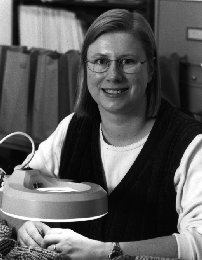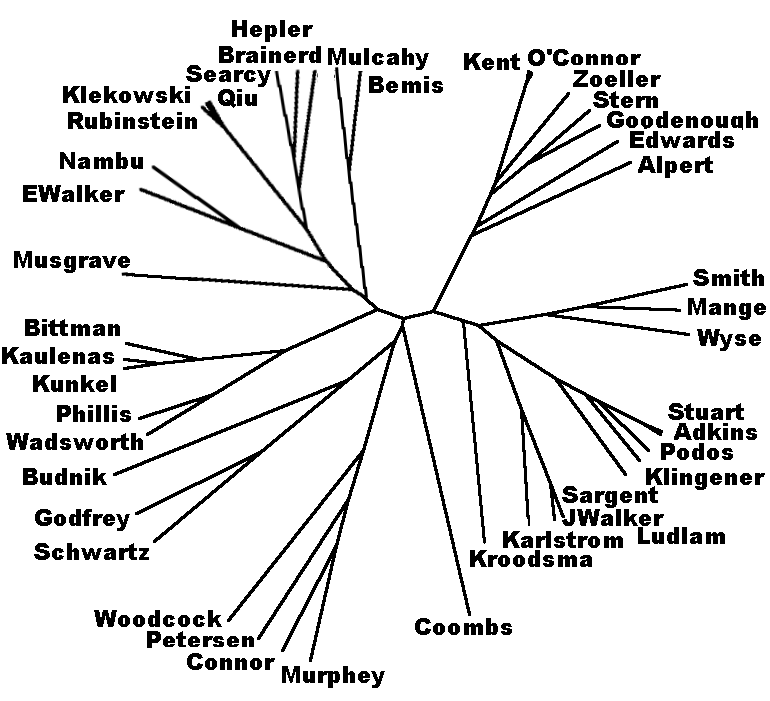|
Don H. Smith '34 BS. Next Issue:(?) List(s) of: (1) Former beneficiaries of Torrey Fund & their present duties. (2) Present beneficiaries of Torrey Fund & their future plans. (3) $$$ Condition of the Torrey Fund. Eds: The Ray Ethan Torrey Scholarship Fund is alive and well. Each year 6-7 undergraduates are provided $500 in support of plant biology research. The Plant Biology Program administers the scholarship and has its own newsletter. |
|
Harold S. Lewis '43 BS. I enjoy your Newsletter! You mentioned Frank Wing '40. Do you have his address? ... an old friend of mine. Ed: Frank Wing, 5431 Granada Blvd, Sebring, FL 33872 |
|
David Marsden '43 BS. Dr. David H. Marsden died Dec. 26, 1999. |
|
Vicky Haard '65 BS. Working part time at "The Naturalist" in Davis CA, enjoying 4 grandchildren, volunteering for Gideons and working on my Private Pilot certification. |
|
Clare (Schloemer) Neuman '66 BS & '68 MAT. I am retired now (2 years) after a 30 year career as a biology teacher. |
|
Mary A. Anderson, '68 BS. Captain Mary Alice (Buck) Anderson, Medical Corps, USN assumed command of the Naval Aerospace Medical Research Laboratory on 5 August 2000. The mission of the laboratory is to conduct research and development in aviation medicine and the allied sciences. Night vision studies, spatial disorientation work, and sound attenuation research are current projects. Eds: Go Buck! |
|
Neil Fennessey BS '75 Zool. I am a professor of civil & environmental engineering at UMass Dartmouth. Specialty area is hydrology and water resource planning and management. My Zoology training helps me communicate with the biology-types but the world is better off that I am not one of them. I still have a passion for auto racing ... shared with my advisor, Dr. Klingener. |
|
John Storella '80 MS I left my position at the law firm in April 2000 and joined Ciphergen Biosystems. We are a proteomics company determined to revolutionize the field of protein biology with a patented SELDI mass spectrometry system. ... We fractionate proteins using a biochromatographic surface, and analyze the captured proteins by mass spectrometry. ... One practical application of the technology is the discovery of diagnostic markers by comparing the proteins from healthy and diseased biological samples. ... On a more personal note, my wife, Lisa, ... is a television producer. Next week she has two pieces airing ... follow-up programs produced by KQED to the Moyer's series on PBS on end of life issues. John |
| Brian Bettencourt '96 BS I successfully defended my PhD dissertation at U. Chicago. ... |
Keep in touch using the various avenues provided:
- Jot down your comments on the enclosed card or letter and send them to:
- Use the electronic route via the Biology Alumni Forum where you can leave Email messages for all participating Biology alumni.
Biology Alumnus Newsletter
Biology Department
University of Massachusetts
Amherst MA 01003-5810
The BioMass Staff
Pumping Iron Alumni
Help on Faculty Timeline
All plants require iron for normal growth and development.
When sufficient quantities of iron are not available, symptoms of
iron-deficiency develop.
Due to its poor solubility, iron is present in soil water in extremely low
concentrations. In response to the paucity of available iron in soil water,
several mechanisms for its uptake have evolved. One of these mechanisms,
chelation, is operative in the grasses, the group of flowering plants that
includes important agricultural crops such as corn, wheat, and rice.
Grass roots secrete compounds called phytosiderophores which chelate iron ions
 present in soil water. Dr. Elsbeth Walker and her research team
have cloned the yellow stripe 1 (ys 1) gene and shown that the
product of chelation, the phytosiderophore-iron complex, is moved across the
plasma membrane of corn root cells by the protein Yellow Stripe 1 (YS 1).
This study appeared in a recent issue of the journal Nature.
present in soil water. Dr. Elsbeth Walker and her research team
have cloned the yellow stripe 1 (ys 1) gene and shown that the
product of chelation, the phytosiderophore-iron complex, is moved across the
plasma membrane of corn root cells by the protein Yellow Stripe 1 (YS 1).
This study appeared in a recent issue of the journal Nature.
The cloning of ys 1 is a significant advance in the elucidation of the
mechanism by which grasses acquire and distribute iron. An understanding
of iron uptake may permit the engineering of iron-rich crop plants that could
play an important role in alleviating iron deficiency anemia which afflicts
three billion people worldwide. Since the iron phytosiderophore chelates
ions other than iron, plants into which ys 1 has been inserted might
prove useful for the removal of metal ions from contaminated soils.
Postcards returned by alumni often contain queries about
professors or instructors with whom we have lost touch over the years.
Our alumni could help the Biology Department by answering some of the
Alumni Mailbag queries. We, on campus, are focusing on the present and
future and have lost track of when particular professors were on campus as
Biology, Zoology or Botany faculty. We are going to try to reconstruct
the historical timeline of faculty residence on campus by sending
a postcard questionnaire to you, our alumni.
 This could be fun and
of interest to our alumni and our current faculty. Help us turn this
accompanying random tree of some of our present and past faculty into a
tree rooted in our memorable past! Please indicate on the accompanying
postcard the years when you were on campus and your most memorable courses and
professors who you think belong on the tree. Using this data we will
construct a timeline and publish it in the next BioMass.
The timeline may jog the memories of other alumni and lead to more information
and Alumni Mailbag queries. Do not hesitate to use Email to speed up the
information gathering process (alumni_forum@bio.umass.edu).
This could be fun and
of interest to our alumni and our current faculty. Help us turn this
accompanying random tree of some of our present and past faculty into a
tree rooted in our memorable past! Please indicate on the accompanying
postcard the years when you were on campus and your most memorable courses and
professors who you think belong on the tree. Using this data we will
construct a timeline and publish it in the next BioMass.
The timeline may jog the memories of other alumni and lead to more information
and Alumni Mailbag queries. Do not hesitate to use Email to speed up the
information gathering process (alumni_forum@bio.umass.edu).